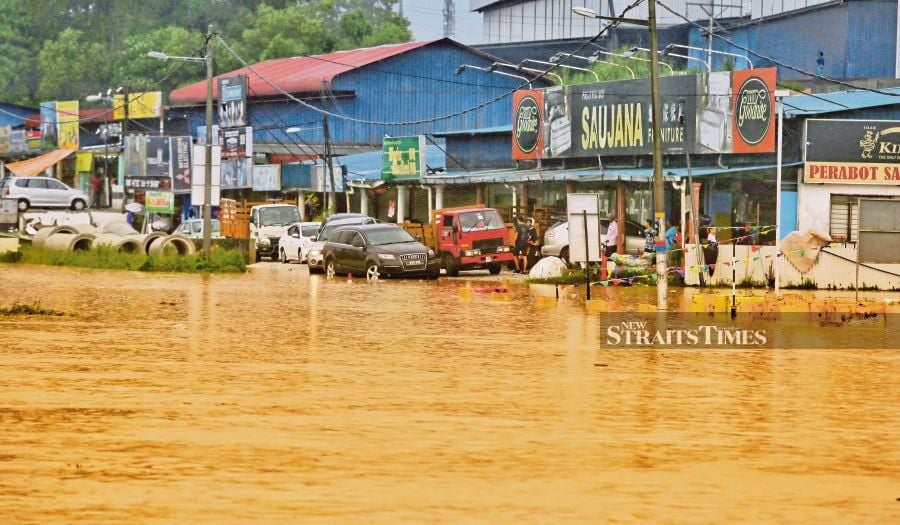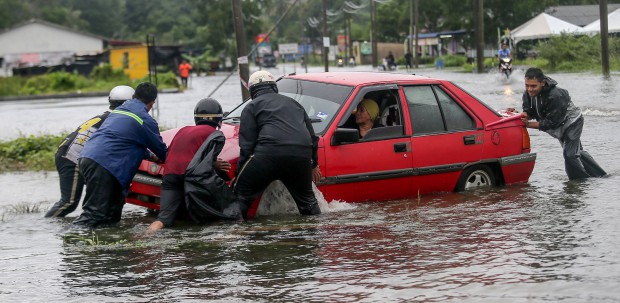IT’S that time of the year again. In October, it rains almost everyday and one can’t help but think of how big the flood is going to be this year.
According to the World Disaster Report (2010), Asia as a whole is most prone to natural disasters.
Flood is the most common and most expensive natural disaster in the country, resulting in chaos in affected areas in terms of disruptions to daily and economic activities, damage to roads and railway tracks, vehicles, properties and even loss of lives.
In addition to natural causes, floods are mainly attributed to continuous heavy rainfall, rapid development, unplanned urbanisation, poor drainage system and environmental degradation.
The December 2014 to January 2015 floods was one of the most devastating ever experienced affecting the whole country including Sabah and Sarawak.
Kelantan, Terengganu and Pahang were the hardest hit where floodwaters ravaged 190,000 hectares of oil palm plantations.
Over 200,000 people were evacuated nationwide, killing at least 20 people. The three most severely affected states registered more than half the total number of evacuees and suffered significant economic losses.
Unprecedented damage was caused to highways, hospitals, universities, schools, properties and agriculture products. Shortages of food, electricity, clean water and communication problems continued to affect flood victims.
Several initiatives were taken by the government in dealing with the flood problem.
These include the establishment of the Permanent Flood Control Commission (PFCC), flood disaster relief machinery, river basin studies, structural and non-structural flood mitigation measures, flood forecasting and warning systems, and hydrological and flood data collection stations. The main objective of the PFCC, with the Drainage and Irrigation Department as its secretariat, is to prevent and mitigate floods.
The flood disaster relief machinery under the Natural Disaster Relief Committee (NDRC) with its secretariat at the National Security Council (NSC) of the National Security Division, Prime Minister’s Department, has the main objective of coordinating relief operations in providing financial assistance from the National Disaster Relief Fund to disaster victims.
The NDRC was established in 1997 through NSC Directive No. 20 which stipulated the national policy, disaster management and aid mechanism. The NDRC followed a three-tier management hierarchy system chaired by the prime minister at the federal level, secretary of state and district officer at the state and district level, respectively.
Subsequently, in October 2015 the federal government established a special agency, National Disaster Management Agency (NADMA), dedicated to disaster risk management and/or other matters related to it.
NADMA is regulated under Directive No. 20 and all matters related to disasters are managed by three-tier committees namely; the Centre for Disaster Management and Relief Committee (CDMRC), chaired by the deputy prime minister at the federal level, the State Disaster Management and Relief Committee (SDMRC), chaired by the secretary of state and the District Disaster Management and Relief Committee, chaired by the District Officer.
It was reported that a total of 68 agencies were involved, consisting of 27 federal agencies, 22 state and 19 district agencies, in seven service themes of disaster management structure which include search and rescue, health and medical services, media, support, security control, welfare, warnings and alerts.
Under the various five-year Malaysia Plans, the government had spent billions of ringgit on flood control and mitigation measures with substantial increment over the years. Records showed that money spent on these projects increased from RM14 million under the Second Malaysia Plan (1971-1975) which ballooned to an estimated RM17 billion between 2006 and 2020.
This showed the seriousness of the government’s commitment to prevent and reduce flood risks.
Money spent on structural flood mitigation projects alone increased four-fold from RM1.79 billion in the period 2001-2005 to RM5.81 billion in 2006-2010.
Major projects include the Stormwater Management and Road Tunnel (SMART) to alleviate the flash flood problem in the Kuala Lumpur city centre.
Despite all these efforts which cost the government billions of ringgit on flood control, mitigation and disaster management, a number of issues have been raised with regard to the effectiveness of the implementation of flood-related policies.
These include lack of coordination between the large number of agencies involved at the federal, state and district levels, imbalance between top-down and bottom-up in disaster management planning approaches which was heavily skewed to the former.
Others include greater emphasis on emergency response phase rather than preparedness and pre-disaster stage, and lack of planning of long-term recovery process which has affected flood victims’ quality of life and well
being.
Hence the focus of the 11th Malaysia Plan (2016-2020) is on strengthening disaster risk management across five phases namely, prevention, mitigation, preparedness, response and recovery. It was reported that the government’s investment in flood mitigation projects is more than RM4 billion beginning with 16 projects at the start of 2018.
An allocation of RM443.9 million and RM150 million was announced in the recent 2020 Budget towards flood mitigation projects and the maintenance of existing flood retention ponds, respectively. The fund should be an impetus for an integrated pro-active planning and a sustainable recovery management.
With a long history of severe flooding, it is unlikely that we will be flood-free in years to come.
The writer is president of the Malaysian Economic Association






